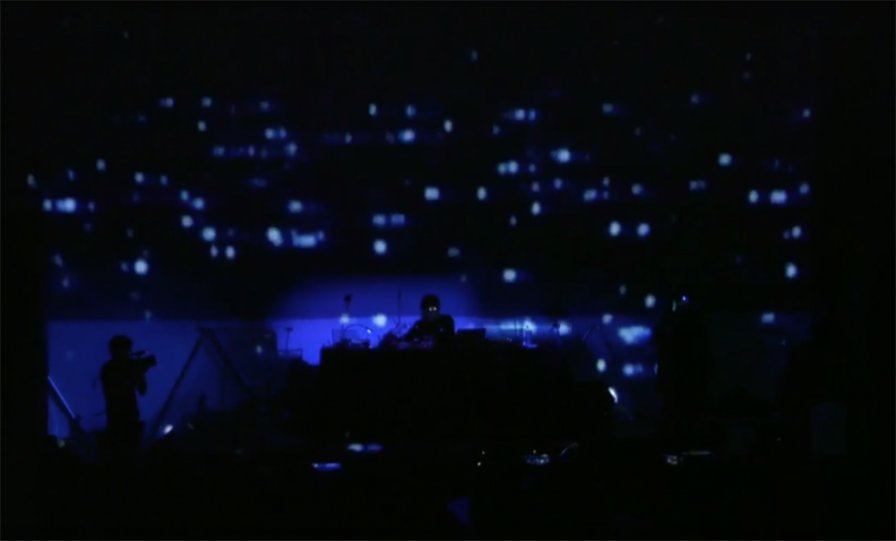If you’ve been at all around these parts, you probably recognize the name ‘William Basinski.’ The 58-year-old “quasi ambient” tape auteur has seen his share of critical attention, namely in a storm of media coverage surrounding his 2002 Disintegration Loops, which processed audio from deteriorating magnetic tape into resounding chaos, collapse, and rebirth that coincided with the 9/11 terror attacks and fit into a wider critical discussion of collective mourning and the role of the arts in the face of national tragedy.
But in the years since, the man’s become something of a grandfather figure for ambient experimentalists everywhere. Following the traditions of his own heroes in Cage, Reich, and Eno, Basinski’s brought the tape tradition into the 21st century, sampling everything from traditional easy-listening to corporate muzak long before fashionable, where with slowed, melancholic overtones, he practically predicted genres and style like screw music, hypnogogic pop, and vaporwave.
It makes perfect sense, then, that he’d find himself billed with Liz Harris, who’s released a staggering number of LPs and CD-Rs as Grouper. Taking the reverent melancholy of electroacoustic folk to its breaking point, Harris has grown into a timeline of experimental harmonies over roughly the last decade, sewing sonic tapestries further and further affected in reverbs and delays with each release. Over the course of 10 years now, she’s built albums around memories of death at sea mimicking and sleep cycles, and collaborated with artists like Xiu Xiu and Xela.
On a cold Sunday afternoon in March, the pair sat before the stage at in the outdoor geodome at MoMA PS1, where a heavy team of Boiler Room Muscle moved about, setting up audio/video equipment for the performance’s livestream. The crowd stood forever, filed in a line around the block. Upon entry, wrists stamped and bags searched, authorities further funneled us into the darkness of the dome, lowly lit in a haze of purple lights as a something from Tim Hecker’s Virgins soundtracked the entry.
A banal New York Art Crowd stood in rowdy clumps, with beer, wine, and coffee helping ease conversation as a few hundred people settled into the space. Contrary to what you might expect for an ambient performance, the whole affair felt like a Sunday social — like everyone who’d just gotten back from SXSW the previous day had eagerly awoken, bright-eyed and against all odds not hungover, only to stand around incessantly with industry friends, another year’s tales of drinking with your editors and failing to save money. But after stepping back — conveniently dodging the rest of a conversation in which the guy next to me called the entire affair “a load of psychedelic dogshit,” Harris soon took the stage, sitting down before a mixer and series of keyboards, one of which looked to be a Yamaha DX7. She slowly pulled sounds in through the mixer, lifting faders as a heavy hum of noise bled into the mix.
With that, the lightning hit. Paul Clipson’s 16mm film projections cut through the room, soaring overhead with hazy aluminum textures coming into focus. Lights skittered out through steel perforations with the rhythm, outlining glass and concrete in jittery monochrome as cityscapes soon rolled into roaring water, muted leaves over boyish silhouettes against the seashore.
As with the concept surrounding Grouper’s The Man Who Died in his Boat, the visuals felt like a grasp at the strangeness of the Oregon coast. Natural images, flecks of light, and sunset are nothing new for video projections, but the film moved with an uncharted rupture of spirit, a warm resound, layering exposure after exposure of affected footage with a lofty, liminal giddiness. Harris soon moved into a more string-leaning collage of new material as the film bounded into neon glows and spectral arrays of dots, racing about in the sterility of an optometry exam. The performance was heavy and affecting, as Harris soon lifted the curtain on each loop, stripping back the mix with each lowered fader until the mangled sounds flattened into a heavy silence before applause.
Basinski then approached the stage, easing the crowd into his set with a charming, campy demeanor. Unlike the tape origins of his career (both in and out of the critical light), here the man opened a laptop, dumping digital audio into the mixer as a looped projection of a river began, smashed and downsampled into a gritty static with rising audio. With slow-moving sounds swelling through murky delays and a sea of indistinguishable hardware to his right, the crowd was encouraged to sit down and relax before the stage, fully immersing themselves in the sound and visuals overhead. As many complied, a chaos of rhythmic pianos lines soon emerged, rolling to the surface in a blistering blur.
Like a Reich’s “Piano Phase,” now slowed and slurred together behind a wall of reverb, the superimposed lines wove in and out of a dense harmonic phase, knitted together with a complex effect chain. The soundtrack moved the crowd in a laconic sway, phasing out over a low-end thunder. About halfway through, he cued a seemingly unedited tape loop from a Mahler-sounding symphony, slowly dubbing the tape with rhythmic delays that rattled into the audience. As the track progressed, he pulled back its low-end, filtering the mix through a sea of EQs to reveal only its shrill, haunting harmonics, a sleight of hand that left the crowd in a state of awe only moments after the set’s conclusion.
It’s hard to put to words what it means to see someone spend his whole career making tape after tape of the stuff, traversing trouble and hardship with an unfazed commitment to the life-affirming sonority of tape music. As he’s noted in the past, things haven’t always been so easy for the composer, and as with many musicians of this nature, it always seems like there’s a strange level of purgatorial quasi-success — recognized in the art world, still not making enough to live on — that comes with furthering contemporary noncommercial artwork in this moment in history.
From the Medicis of Florence to the lone ticket holders in the back of the room, as artists — as a public — we need patronage. Beyond ensuring a good time at gallery events, good patronage in the present moment is maybe the last thing that has kept the critical world spinning, allowing artists — some of whom continue to struggle even at the peak of their careers — to continue what matters most. As students, we’re trained to push forward the boundaries of the critical landscape in ways that are undoubtedly culturally necessary, but often times, there’s really no given formula for asking for help in the process beyond an occasional grant or tenured university position.
Artists need both critical platforms and the economic scaffolding associated with patronage (and the art market) to allow their work to flourish in full force. To continue the existence of groundbreaking art in all forms — to continue to tell generations of artists that their creative output has value beyond economic ends — is forever the essential conundrum of arts patronage, and while it’s both a blessing and a curse that these are even necessary in 21st century globalcapitalism, it’s such an overwhelming blessing to be a part of communities that value critical, contemporary patronage on this scale. Especially in an arts community that feels as hackneyed and stamped upon as New York does these days.
Contemporary spaces like this are important, and I left PS1 feeling that. With a few fresh books, renewed faith, and a little bit of time to kill, I sat down in a nearby diner and found the best things anyone could ask for: a hot plate of eggs, a bottomless coffee, and the inspiration, finally, to start working out something new.
More about: Grouper, Liz Harris, William Basinski



